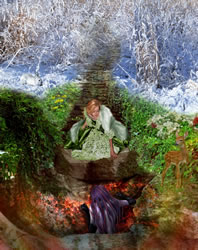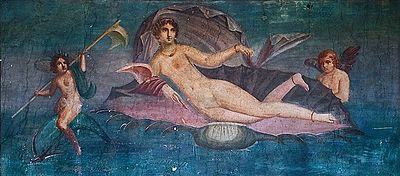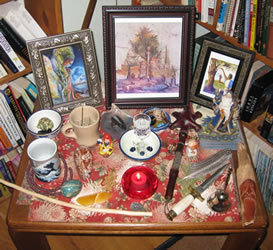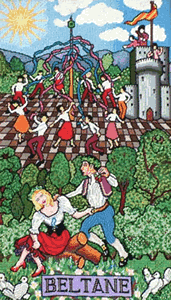
Bibliography and Links
Beltane, May Day, May 1st,
Walpurgis Nacht, Easter, Neopagan Celebrations
April Events
April 1 Veneralia: Roman Festival in honor of the Goddess Venus (Greek: Aphrodite), the Festum Veneris et Fortunae Virilis.
April 8 Buddha's Birthday
April 22 Earth Day
April 24 World Tai Chi Day
April 27 - May 3 Floralia Roman spring celebration in honor of the Goddess Floralia
April 30 Arbor Day
April 30 Walpurgis Nacht Northern European Neopagan holiday
April Easter, Christian holy day, on a Sunday, date varies from year to year
May 1 Beltane, May Day, May Eve
May 1-3 Green Man Festival
Ancient Ways by Pauline Campanelli. Wonderful folk celebrations for the seasons.
Aphrodite
Greek Goddess of sexuality, love, and war. Compare with Inanna/Ishtar from
Sumeria.
April:
Quotes, Poems, Sayings, Lore, Gardening Chores
Aprilis Calendar, Societas Via Roma By M. Moravius Horatius Piscinus.
The Art
of Ritual by Renee Beck
Artemis - Encyclopedia
Mythica
Artemis Greek
goddess associated with wild places, forests, hunting, wild animals, childbirth,
virgins and young girls. Her Roman equivalent is Diana.
Artemis Festival: Greek goddess. Her festival was celebrated around
the 16th of April (Mounichion).
Astaru Holidays
Germanic and Northern Heathen Celebrations
Attis
A Phyrgian and Greek God associated with vegetation, death (autumn) and rebirth
(spring) cycles, fig trees, and eunuchs.
Aurora
(Roman Goddess of dawn)
The Babylonian Origins of Easter (Ishtar)
Bacchus (Roman
god) or Dionysus
(Greek god) associated with fertility god, wild nature, wine, trees, fig trees,
outsiders, licentiousness, intoxication, lovemaking, ecstasy. The feast
day in honor of Bacchus in Rome was March 16 and 17th, the
Bacchanalia. In
America, this kind of feasting and wild partying is called "Spring Break" during
the traditional week off from college during the week before or after Easter.
The Mardi Gras celebrations in New Orleans and South America are quite similar
in nature.
Beltane Lore and
Rituals by Selena Fox
Beltane Rite by Llyn Hydd Druid Grove
Beltane Rite by
Shadow Weaver Grove ADF
Beltane: The Season of Beltane from the Druid Network
Beltane: Springtime Rituals, Lore and Celebration
by Raven Grimassi
Beltane - Tara Celebrations Lovely photographs of Celtic Neopagan
celebrations at Tara, Ireland.
A Book of Pagan Prayer
by Ceisiwr Serith. An extensive collection of pagan prayers.
Flora by L. Abbema, 1913
Calling the Quarters, Casting the Circle, Magickal Protective Sphere, Creating the Sacred Sphere
Celebrate the Earth: A Year of Holidays by Laurie Cabot and Jean Mills.
Celebrating the Seasons of Life: Beltane to Mabon by Ashleen O'Gaea. A good
study of four spring and summer celebrations that is rich in details and ideas.
Cherry Blossom Festival (Sakura)
Cherry Blossom Festival of Greater Philadelphia
Circles,
Groves and Sanctuaries: Sacred Spaces of Today's Pagans. Compiled
by Dan and Pauline Campanelli. Ideas
for creating
indoor and outdoor altars and sanctuaries.
Cloud Hands Blog Mike
Garofalo writes about Gardening, Taijiquan, Mysticism, Walking, Qigong, and the
Eight Ways.
Creating Circles and Ceremonies: Rituals for all Seasons and Reasons by
Morning Glory Zell-Ravenheart. This
is a valuable collection of information, poetry, rituals, songs, and craft
activities for seasonal celebrations.
Cunningham's
Encyclopedia of Magical Herbs by Scott Cunningham
Dictionary of Green and Roman Mythology and Biography by William Smith in
1869
Dionysus (Greek) or Bacchus
(Roman)
Dionysus
Greek fertility god, wild nature, wine, trees, fig trees, outsider god, ecstasy.
His feast days are more in the autumn than spring.
Divination Methods: Tarot
Most Holy Day rituals include using some method for divination: Runes, Oghams,
Tarot, Gazing, or Signs. I use either the Crowley Thoth Tarot or the
Voyager Tarot.
Draioch: Rites of Celtic Sorcery. By Ian Corrigan
A
Druid's Herbal for the Sacred Year by Ellen Evert Hopman. Thorough
research on the uses and lore of herbs.
Earth Day is celebrated on
April 22nd.
Easter Page: Traditions
and History
Easter, Passover, and Other Spring Festivals
by Ann Morrill
The Eight Seasonal Religious
Celebrations of Neopagans, Druids, Taoists, Wizards, Solitaries
The Elements of Ritual: Air, Fire, Water and Earth in the Wiccan Circel by
Deborah Lipp
Exploring the Northern Tradition by Galina Drasskova
Fairies, Elves, Nature Spirits:
Lands Spirits, Alfs, Wights, Lars, Trolls, Dwarves, Sidhe,
Devas, Otherworld, Little Folk
February:
Quotes, Poems, Celebrations, Lore, Garden Chores
Flora
The Roman goddess of flowers and spring time.
Flora,
Roman Goddess. Feast Day, Floralia,
April 27th - May 3rd
Floralia - Encyclopedia of Rome
Floralia - Encyclopedia
Mythica
Floralia - Florales Ludi Festival, W. Smith's Dictionary of Green and Roman
Antiquities, 1875
Freya A Norse
Goddess worshipped in Germanic Heathenism and who is associated with beauty,
love, fertility, divination, healing, motherhood, gold, death, and warrior
cults. She wears the necklace Brisingamen, wears a clock of falcon
feathers, and rides a chariot pulled by wild cats, and her familiar is cats or a
wild boar.
Freyr A Norse God
worshipped in Germanic Heathenism and who is associated with farming, weather,
and is a phallic fertility God.
The Green Man (Powers
of Spring and Summer): Bibliography, Links, Quotes, Information, Lore,
Myths, Role
Heathen Gods in Old English Literature by Richard North, 1997
High Days, Sacred Days in
the Year, High Holy Days of NeoPaganism
Inanna
Sumerian Goddess: Nin-anna
"Queen of Heaven" Goddess of sexual love, fertility, and warfare.
Inanna: Journey to the
Dark Center
Inanna,
Queen of Heaven and Earth: Her Stories and Hymns from Sumer by Diane Wolkstein and Samuel Noah Kramer
In
Nature's Honor: Myths and Rituals Celebrating the Earth by Patricia Montley
Months and Seasons
Quotes, Poems, Sayings, Verses, Lore, Myths, Holidays
Celebrations, Folklore, Reading, Links, Quotations
Information, Weather, Gardening Chores
Compiled by Mike Garofalo
June:
Quotes, Poems, Celebrations, Lore, Garden Chores
Labyrinths:
Lore, Bibliography, Links, Resources, Quotes
Lammas, Lughnasadh, Summer Festival, First
Harvest, August 1st
Land Spirits, Nature Spirits:
Fairies, Elves, Alfs, Wights, Trolls, Dwarves, Sidhe,
Devas, Otherworld, Little Folk, Ancestors, Ghosts
Librarian of
Gushen Grove, Michael P. Garofalo, M.S.L.S., Red Bluff, California, aka
The Green Wizard
The Magickal Year: A Pagan Perspective on the Natural World
by Diana Ferguson
March: Quotes, Poems,
Sayings, Lore, Gardening Chores
March Ritual Days and Sacred Days
May: Quotes, Poems,
Sayings, Lore, Gardening Chores
Months of the Year: Quotes, Poems, Reading List, Links,
Garden Chores, Holidays
The
Mysteries of Druidry: Celtic Mysticism, Theory and Practice by
Brendan Cathbad Myers
Nature Spirits: Fairies, Elves, Alfs, Wights, Lars, Trolls, Dwarves, Sidhe,
Devas, Otherworld, Little Folk, Ghosts
Neopagan Rites: A Guide to Creating Public Rituals that Work by Isaac Bonewits
Northern Tradition for the Solitary Practitioner: A Book of Prayer, Devotional
Practice, and the Nine Worlds of the Spirit by Galina Krasskova and Raven Kaldera
The Obscure
Goddess Online Directory and the A-Muse-ing Grace
Gallery and the Art of Thalia Took
One
Old Druid's Final Journey - The Notebooks of the Librarian of Gushen Grove
Order of Bards Ovates and Druids.
The largest Druid organization in the world. A complete training program
in print and audio versions, discussion groups, library, extensive resources.
I am a member of this Order as a Bardic Grade student.
The OBOD celebrates the Eight Holy Days of NeoPaganism.
I find their liturgical cycle and rituals to be
spiritually uplifting, wholesome, life affirming, earth centered, ecologically
positive, profound, polytheistic, and open minded. OBOD is more orientated
towards Celtic spirituality.
Oriental Religions
in the West. By Sir James Frazer, 1922.
Ostara: Customs, Spells & Rituals for the Rites of Spring
By Edain McCoy
Ostara,
Eostre, Austro A goddess in Anglo-Saxon Germanic paganism honored with
a ritual celebration in the month of April. Customs included the use of
eggs and hares - still popular in Easter celebrations in our own generation. Her
name means "East," and she is related to a dawn goddess, which would account for
Greek "Eos", Roman "Aurora",
and Indian "Ushas."
She is a spring fertility goddess. Related to the Germanic goddess
Rheda (Herde),
associated with the month of March.
Ostara, Spring
Equinox Celebration
Osterraeder: Mysteries of the Osterraeder
Pagan Prayers by Ceisiwr Serith. A wonderful collection of thoughtful
prayers and reflections.
Paganism:
An Introduction to Earth-Centered Religions by Joyce and River
Higginbotham
Pan A Greek satyr or
god. Associated with wild places, rustic music, sexuality, hunting,
shepards and flocks, panic/terror, woods, pastures, mountains, and fertility.
The Roman gods of Faunus, and Faun (Bona Dea) are similar. As the Horned
God in modern Wicca, his importance and shifted in a more positive direction.
In the 19th century, Christians gave the Devil (Satan) the appearance of Pan.
Persephone
Greek Goddess of Springtime, Queen of the Underworld, daughter of Demeter, wife
of Hades.

Persephone and Demeter by Svet-Svet
Pulling Onions
by Mike Garofalo
Red Bluff,
California. Natural History Studies at our Home and Gardens.
By Karen and Mike Garofalo.
Roman Pagan Holy Days, Seasonal
Celebrations, Religious Customs, Roman Pagan Hearth
The
Sabbats: A New Approach to Living the Old Ways by Edain McCoy.
Practical suggestions for celebrating the pagan holidays in the Wheel of the
Year.
Sacred Circles
Bibliography, Links, Quotes, Notes. Photos of the Gushen Grove
sacred circle construction project.
Sacred
Fire, Holy Well: A Druid's Grimoire by Ian Corrigan.
Excellent resources for liturgy.
Sexual
Magic: Bibliography, Links, Quotes
The
Solitary Druid: A Practitioner's Guide by Robert Lee (Skip) Ellison
Solitary
Witch: The Ultimate Book of Shadows for the New Generation by Silver
Ravenwolf.
The
Spiral Dance: A Rebirth of the Ancient Religion of the Great Goddess.
Rituals, invocations, exercises, and magic. By Starhawk. 10th
Anniversary
Edition, Revised and updated. A very influential work on Goddess worship and
pagan religious practices.
The Spirit of Gardening
3,800 quotes, poems, sayings, and ideas about gardening, gardens, and the Green
Way. Materials organized by 250 topics; and a fully indexed collection
with a search engine. Online since 1999. Over 6MB of text.
Compiled by Michael P. Garofalo.
Spring -
Quotes, Poems, Sayings
and Quips for Gardeners
Summer -
Quotes, Poems, Sayings
and Quips for Gardeners
Valley Spirit
Sacred Circle, Red Bluff, California
Veneralia
(April 1), a Roman religious holiday, was held in honour of Venus Verticordia
("Venus the Changer of Hearts"), and
Fortuna Virilis
(Virile or strong Good Fortune), whose cult was probably by far the older of the
two.
Venus, Roman Goddess, April 1st
Festival in Rome. Venus is similar to the Greek Goddess, Aphrodite.
Vesta Roman
goddess of hearth, kitchen, fire, stove, and home.
Vinalia urbana (April 23), a Roman wine festival shared by Venus and
Jupiter.

Venus on a seashell, from the Casa di Venus, Pompei, circa 79 CE.
Walpurgis Nacht Images from Wikipedia
Walkers
Between the Worlds: The Western Mysteries from Shaman to Magus by Caitlin and John Matthews
Wheel
of the Year: Living the Magical Life by Pauline Campanelli
Wheel of the
Year, High Days, Seasonal Celebrations, NeoPagan Holidays
Wicca:
A Guide for the Solitary Practitioner by Scott Cunningham
Winter - Quotes, Poems, Sayings,
and Lore
Wisdom
of the Elements: The Sacred Wheel of Earth, Air, Fire and Water by Margie
McArthur
Return to the Main Index on this Webpage
|
Beltane, Spring, May Day |
|
|
|
|
|
Time of Day |
|
|
Time of Life |
|
|
Decorations |
Flowers, flowering branches, leafing branches |
|
Fruits |
Wine, dried fruits, figs |
|
Herbs |
|
|
Tools |
Candles, Fire Pits, Axes, |
|
Goddesses |
Aphrodite, Freyja, Persephone, Venus |
|
Gods |
Attis, Bacchus, Dionysus, Freyr |
|
Themes |
Fertility, romance, lovemaking, flowering, budding, revelry |
|
Farming Activities |
Seed planting, fertilizing |
|
Animals |
|
|
Colors |
Green |
| Southeast, | |
|
Celebrations & Activities |
Beltane Fires, Maypole dances, bonfires, dancing, lovemaking, staying up all night in the woods, baskets of flowers, washing face in morning dew, decorating with green budding branches, burning money |
Return to the Main Index on this Webpage
General Preparations
Beltane, May Day, May 1st,
Walpurgis Nacht, Easter, Neopagan Celebrations
1. Clean up your garden, rake leaves, water as needed, put down fertilizer. If you last frost date is in April, then you can begin to plant seeds and seedlings. Do work appropriate for your agricultural Zone. I live in Red Bluff, California, USDA Zone 9, Northern Hemisphere. My April gardening chores might be quite different from yours, depending upon where you live.
2. Do spring cleaning in your home. Wipe up the dust. Wash windows. Give away unneeded items. Scrub walls. Bring in some potted plants.
3. Working and meditating in the garden is an important facet of my spiritual path. I need to regularly reconnect with the earth and with the beauty and energy of the Spring season outdoors. Tend your garden daily. Water your garden each day. Weed your vegetable garden. Harvest from your late winter garden if you can grow on. Review your own lists of chores for April and May, and act accordingly.
4. Read about Beltane, May Day, Walpurgis Nacht and other mid-Spring celebrations around the world. Add notes and links to books, magazines, and webpages on the subject. See my bibliography and links above. Visit your local public library or college library to obtain access to books, media and magazines on the subject. Study about ancient Indo-European religions. I update my Months webpages on April and May.
5. Add some appropriate Beltane, May Day, Walpurgis Nacht and mid-Spring songs, chants, prayers, reflections, invocations, or poems to your Neo-Pagan Craft Journal, Book of Shadows, blog, website, or Ritual Handbook. Write in your personal journal. Most spiritual seekers keep a notebook, journal or log as part of their experimental, creative, magical and experiential work.
6. Stay at home. Improve your home, backyard, or garden. Eliminate long driving trips. Do you really need to "Go" anywhere? Do you really need to fly by airplane to another country? Explore your backyard, neighborhood, local community, nearby city, county wide area, regional area within 50-100 miles. Visit a local "sacred site." For us, for example, this could be Mt. Shasta, the headwaters spring of the Sacramento River in Mt. Shasta City, the Sacramento River at Woodson Bridge Park, a long walk in the forest below nearby Mt. Lassen, sitting on the shore of Whiskeytown Lake, sitting in my backyard in the moonlight, or visiting a beautiful church or college or park that is nearby. Watch a DVD on a spiritual subject, sacred place, or inspirational topic. Learn more about your local environment.
7. Read solitary or group rites for Beltane, May Day, Walpurgis Nacht, Easter or other mid-spring celebrations available in books and webpages (see above). Create your own ritual for Beltane. Practice the ritual. Conduct the ritual at a convenient time for you, or your family and/or friends, as close to the day of May 1st as possible. Attend a public Beltane ritual of a local NeoPagan group.
8. Improve your indoor home altar. Clean and shine everything up on the altar. Place a fresh offering on your home altar every day in April. Add fresh flowers to the altar. Bring in branches of trees that are budding out. In Ireland, and were Celtic traditions are popular, the word "Bel" refers to a bright fire, a large bonfire, white, or bright, the month of May, and the beginning of the warm and bring summer season. Therefore, lighting candles will be an essential aspect of home piety. My home altar includes Druid, Roman, Wiccan, and Western Magickal influences, and is shown in the following two photos:


9. Key a close eye on flowering tree and shrub branches and leaf budding tree and shrub branches in yards and gardens. This rebirth or resurrection of vegetation is essential to the meaning of this season. Many gods and goddesses are associated with this rebirth, e.g., Persephone, Attis, Osiris, Jesus Christ. Bring some of these reborn branches into your home and home altar.
Return to the Main Index on this Webpage
Quotations, Information,
Facts, Lore
Beltane, May Day, May 1st,
Walpurgis Nacht, Easter, Neopagan Celebrations
"Many Wiccans and Pagans celebrate Beltane.
It is one of eight solar Sabbats. This holiday incorporates traditions from
the Gaelic Bealtaine, such as the bonfire, but it bears more relation to the
Germanic May Day festival, both in its significance (focusing on fertility) and
its rituals (such as May pole dancing). Some traditions celebrate this holiday
on May 1 or May day, whiles others begin their celebration the eve before or
April 30th. Beltane has long been celebrated with feasts and
rituals. The name means fire of Bel; Belinos being one name for the Sun God,
whose coronation feast we now celebrate. As summer begins, weather becomes
warmer, and the plant world blossoms, an exuberant mood prevails. In old Celtic
traditions it was a time of unabashed sexuality and promiscuity where marriages
of a year and a day could be undertaken but it is rarely observed in that manner
in modern times. In the old Celtic times, young people would spend the entire
night in the woods "A-Maying," and then dance around the phallic Maypole the
next morning. Older married couples were allowed to remove their wedding rings
(and the restrictions they imply) for this one night. May morning is a magickal
time for wild water (dew, flowing streams, and springs) which is collected and
used to bathe in for beauty, or to drink for health."
- Beltane by Herne
"Easter is named for a Saxon goddess who was
known by the names of Oestre or Eastre, and in Germany by the name of Ostara.
She is a goddess of the dawn and the spring, and her name derives from words for
dawn, the shining light arising from the east. Our words for the "female
hormone" estrogen derives from her name. Ostara was, of course, a
fertility goddess. Bringing in the end of winter, with the days brighter and
growing longer after the vernal equinox, Ostara had a passion for new life. Her
presence was felt in the flowering of plants and the birth of babies, both
animal and human. The rabbit (well known for its propensity for rapid
reproduction) was her sacred animal. Easter eggs and the Easter
Bunny both featured in the spring festivals of Ostara, which were initially held
during the feasts of the goddess Ishtar | Inanna. Eggs are an obvious symbol of
fertility, and the newborn chicks an adorable representation of new growth.
Brightly colored eggs, chicks, and bunnies were all used at festival time to
express appreciation for Ostara's gift of abundance."
-
Easter History
"Every morning was a cheerful invitation to make my life
of equal simplicity, and I may say innocence, with Nature herself. I have
been as sincere worshipper of Aurora as the Greeks. I got up early and
bathed in the pond; that was a religious exercise, and one of the best things
which I did."
- Henry David Thoreau, Walden, Chapter 2
"In Roman mythology, Flora was a goddess of flowers and the season of spring. While she was otherwise a relatively minor figure in Roman mythology, being one among several fertility goddesses, her association with the spring gave her particular importance at the coming of springtime. Her festival, the Floralia, was held between April 28 and May 3 and symbolized the renewal of the cycle of life, drinking, and flowers. The festival was first instituted in 240 B.C.E but on the advice of the Sibylline books she was given another temple in 238 B.C.E. Her Greek equivalent was Chloris, who was a nymph and not a goddess at all. Flora was married to Favonius, the wind god, and her companion was Hercules. Her name is derived from the Latin word "flos" which means "flower." In modern English, "Flora" also means the plants of a particular region or period. Flora achieved more prominence in the neo-pagan revival of Antiquity among Renaissance humanists than she had ever enjoyed in ancient Rome."
"Walpurgis
Night (Walpurgisnacht) is a traditional
spring festival on 30 April or 1 May in large parts of
Central and
Northern Europe. It is often celebrated with dancing and with
bonfires.
The current festival is, in most countries that celebrate it, named after the
English missionary
Saint Walburga (ca. 710–777/9). As Walburga was canonized on 1st of May (ca.
870), she became associated with
May Day,
especially in the Finnish and
Swedish calendars.[1][2]
The eve of May day, traditionally celebrated with dancing, came to be known as
Walpurgisnacht ("Walpurga's night"). The name of the holiday is
Walpurgisnacht in
German and
Dutch, Valborgsmässoafton in
Swedish, Vappu in
Finnish, Volbriöö, (Walpurgi öö) in
Estonian, Valpurgijos naktis in
Lithuanian, Valpurģu nakts or Valpurģi in
Latvian, čarodějnice or Valpur˛ina noc in
Czech, chódotypalenje
Lower Sorbian and chodojtypalenje in
Upper Sorbian."
- Wikipedia
"Venus
is a
Roman goddess
principally associated with
love,
beauty, sex,
fertility, prosperity and military victory. She played a key role in many
Roman religious festivals. From the third century BC, the increasing
Hellenization of Roman upper classes identified her as the equivalent of the
Greek goddess
Aphrodite
which in turn is the copy and the equivalent of the
Phoenician
goddess Astarte.
Roman mythology made her the divine mother of
Aeneas, the
Trojan ancestor of
Rome's founder,
Romulus. Venus was offered
official (state-sponsored) cult in certain
festivals of the Roman calendar. Her sacred month was April (Latin Mensis
Aprilis) which Roman etymologists understood to derive from aperire,
"to open," with reference to the springtime opening of trees and flowers.
Veneralia
(April 1) was held in honour of Venus Verticordia ("Venus the Changer of
Hearts"), and
Fortuna Virilis (Virile or strong Good Fortune), whose cult was probably by
far the older of the two.
Vinalia urbana (April 23), a wine festival shared by Venus and
Jupiter, king of the gods. Venus was patron of "profane"
wine, for everyday human use. Jupiter was patron of the strongest, purest,
sacrificial grade wine, and controlled the weather on which the autumn
grape-harvest would depend. At this festival, men and women alike drank the new
vintage of ordinary, non-sacral wine in honour of Venus, whose powers had
provided humankind with this gift"
- Wikipedia
"May Day
is related to the
Celtic festival of
Beltane and
the
Germanic festival of
Walpurgis Night. May Day falls exactly half a year from November 1, another
cross-quarter day which is also associated with various northern European
pagan and
neopagan festivals such as
Samhain. May
Day marks the end of the unfarmable winter half of the year in the Northern
hemisphere, and it has traditionally been an occasion for popular and often
raucous celebrations. As Europe became Christianized the
pagan
holidays lost their religious character and either changed into popular secular
celebrations, as with May Day, or were
merged with or replaced by new
Christian
holidays as with
Christmas,
Easter,
Pentecost
and
All Saint's Day. In the twentieth century, many
neopagans began reconstructing the old traditions and celebrating May Day as
a pagan religious festival again."
- Wikipedia
"In
Greek mythology,
Persephone (Περσεφόνη), also called Kore (the maiden), is the daughter of
Zeus and the
harvest-goddess
Demeter, and queen of the
underworld.
Homer describes her as the formidable, venerable majestic queen of the
shades, who carries into effect the curses of men upon the souls of the dead.
Kore was abducted by
Hades, the god-king of the underworld. The myth of her abduction
represents her function as the
personification of
vegetation
which shoots forth in
spring and withdraws into the earth after harvest; hence she is also
associated with spring and with the seeds of the fruits of the fields. Similar
myths appear in the
Orient, in the cults of male gods like
Attis,
Adonis and
Osiris, and in
Minoan Crete.
Persephone as a
vegetation goddess (Kore) and her mother
Ceres were the
central figures of the
Eleusinian mysteries that predated the
Olympian pantheon, and promised to the initiated a more enjoyable prospect
after death. The mystic Persephone is further said to have become by
Zeus the mother of
Dionysus,
Iacchus, or
Zagreus. The
origins of her cult are uncertain, but it was based on very old agrarian cults
of agricultural communities. Persephone was commonly worshiped along with
Demeter, and
with the same mysteries. To her alone were dedicated the mysteries celebrated at
Athens in the month of
Anthesterion. Her common name as a vegetation goddess is
Kore and in
Arcadia she
was worshipped under the title
Despoina
"the mistress", a very old chthonic divinity.
Plutarch
identifies her with spring and
Cicero calls
her the seed of the fruits of the fields. In the
Eleusinian mysteries her return is the symbol of immortality and hence she
was frequently represented on sarcophagi."
- Persephone
"Fertility rights are ceremonies of a magic-religious
nature performed to ensure the perpetuation of mankind and to control the
environment. Expressed as invocations, incantations, prayers, hymns,
processions, dances, and sacred dramas, these liturgical endeavors were, and
still are, believed to be closely connected with the mechanisms of nature.
The basis for such rites is usually a belief in sympathetic magic - that is
magic worked on one level to have an effect on a different level, and based on
the assumption that life and fertility, whether animal or vegetable, are one and
indivisible. If such fertility rites could induce fertility in the animal
and human worlds, then the vegetable world would also be stimulated to
reproduction, resulting in an abundant harvest."
- Robert Ellison, The Solitary Druid, p. 130

Return to the Main Index on this Webpage
Poems, Prayers, Rites, Liturgy,
Invocations
Beltane, May Day, May 1st,
Walpurgis Nacht, Easter, Neopagan Celebrations
"The leaves are budding across the land
on the ash and oak and hawthorn trees.
Magic rises around us in the forest
and the hedges are filled with laughter and love.
Dear lady, we offer you a gift,
a gathering of flowers picked by our hands,
woven into the circle of endless life.
The bright colors of nature herself
blend together to honor you,
Queen of spring,
as we give you honor this day.
Spring is here and the land is fertile,
ready to offer up gifts in your name.
we pay you tribute, our lady,
daughter of the Fae,
and ask your blessing this Beltane."
-
Beltane Prayers
"Beltaine Fire and Beltaine Blood
Great earth mother!
We give you praise today
and ask for your blessing upon us.
As seeds spring forth
and grass grows green
and winds blow gently
and the rivers flow
and the sun shines down
upon our land,
we offer thanks to you for your blessings
and your gifts of life each spring.
"Bless, O Threefold Goddess,
My Coven, my family, and myself
My pets, my plants, and all children
of the Great Mother.
On the fragrant plain, on the tall
mountain slopes
On the fragrant plain, on the tall
mountain slopes.
Everything within my dwelling or in my
possession,
From Beltane Eve to Samhain Eve,
From Samhain Eve to Beltane Eve,
With goodly progress and gentle
blessing,
From sea to sea, and every river
mouth,
From wave to wave, and base of
waterfall.
Be thy Three Faces taking possession
of all belonging to me,
Be the Watchtowers four protecting me
in truth;
Oh! Satisfy my spirit with the warmth
of Belinos,
And shield my loved ones between the
Beltane fires,
Shield my loved ones between the
Beltane fires.
Bless everything and every one,
Of this little household by my side;
Place the pentagram of the Lady upon
us
Till we see the Land of Promise.
Till we see the Land of Promise.
What time the kine shall forsake the
stalls,
What time the sheep shall forsake the
folds,
What time the goats shall ascend the
mount of mist,
May the tending of the Triad follow
them,
May the tending of the Triad follow
them.
Thou are being who didst give me
birth,
Listen and attend to me as I bow my
head,
Evening and morning as is becoming in
me,
In thine own Circle, O Goddess of
Love.
In thine own Circle, O Goddess of
Love."
- Rowan Morgana,
Sacred Wicca
"Unite and unite and let us
all unite,
For summer is acome unto day,
And whither we are going we will all unite,
In the merry morning of May.
I warn you young men everyone
For summer is acome unto day,
To go to the green-wood and fetch your May home
In the merry morning of May."
"Oh, give
us pleasure in the flowers to-day;
And give us not to think so far away
As the uncertain harvest; keep us here
All simply in the springing of the year.
Oh, give us pleasure in the orchard white,
Like nothing else by day, like ghosts by night;
And make us happy in the happy bees,
The swarm dilating round the perfect trees.
And make us happy in the darting bird
That suddenly above the bees is heard,
The meteor that thrusts in with needle bill,
And off a blossom in mid air stands still.
For this is love and nothing else is love,
The which it is reserved for God above
To sanctify to what far ends He will,
But which it only needs that we fulfill."
- Robert Frost, A Prayer for Spring
"Oh Earth-Mother
We praise thee
That seed springeth
That flower openeth
That grass groweth.
We praise thee
For winds that whisper
Through the shining Birch
Through the lively Pines
Through the mighty Oak.
We praise thee
For all things
Oh, Earth-Mother, who gives all life."
- Beltane Rite
by Shadow Weaver Grove ADF
Return to the Main Index on this Webpage
Mike Garofalo's Notes
Beltane, May Day, May 1st, Walpurgis Nacht, Easter, Neopagan Celebrations
My notes, observations, listing of local activities, and studies on the Beltane, May Day, May 1st, Walpurgis Nacht, Easter, Neopagan Celebrations.
I've beem to the Gwers of the OBOD while I walk in the early morning (3/2012). Very inspiring.
Kathy Goodin gave us a large Hawthorn tree. Karen and I planted it in our Sacred Circle Garden.
Months and Seasons
Quotes, Poems, Sayings, Verses, Lore, Myths, Holidays
Celebrations, Folklore, Reading, Links, Quotations
Information, Weather, Gardening Chores
Compiled by Mike Garofalo
Return to the Main Index on this Webpage
Green Way Research, Cloud Hands Home,
Vancouver, Washington, Northwest USA
Green Way Research, © 2010-2017.
Indexed and Compiled by
Michael P. Garofalo

Created by Michael P. Garofalo,
Green
Way Research, Valley Spirit
Center, Gushen Grove Notebooks, Red Bluff, North Sacramento Valley, California,
USA (2010-2017)
Revised and updated by Mike Garofalo,
Cloud Hands Home, City
of Vancouver, State of Washington, Northwestern USA (April 2017-)
This webpage was first published on the Internet on November 5, 2010.
This webpage was last updated or changed: April 18, 2017; May 7, 2012.
Brief Biography of Michael P. Garofalo, M.S.
Ripening Peaches: Daoist Studies and Practices
Zhuangzi (Chuang Tzu, Zhuang Zhou, Master Chuang) 369—286 BCE
Taoist Perspectives: My Reading List
Bodymind Theory and Practices, Somaesthetics
How to Live a Good Life: Advice from Wise Persons
Pleasures, Satisfaction, Desires
Qigong (Chi Kung) Health Practices
One Old Daoist Neopagan's Final Journey: Notebooks of the Librarian of Gushen Grove
Index to Cloud Hands and Valley Spirit Websites
Index to English Language Translators of the Tao Te Ching
Recurring Themes (Terms, Concepts, Leimotifs) in the Tao Te Ching
Spanish Language Translations of the Tao Te Ching
The Tao Te Ching (Dao De Jing) by Lao Tzu (Laozi) circa 500 BCE
|
Tao Te
Ching |
|||||||||
| 1 | 2 | 3 | 4 | 5 | 6 | 7 | 8 | 9 | 10 |
| 11 | 12 | 13 | 14 | 15 | 16 | 17 | 18 | 19 | 20 |
| 21 | 22 | 23 | 24 | 25 | 26 | 27 | 28 | 29 | 30 |
| 31 | 32 | 33 | 34 | 35 | 36 | 37 | 38 | 39 | 40 |
| 41 | 42 | 43 | 44 | 45 | 46 | 47 | 48 | 49 | 50 |
| 51 | 52 | 53 | 54 | 55 | 56 | 57 | 58 | 59 | 60 |
| 61 | 62 | 63 | 64 | 65 | 66 | 67 | 68 | 69 | 70 |
| 71 | 72 | 73 | 74 | 75 | 76 | 77 | 78 | 79 | 80 |
| 81 | |||||||||
Return to the Top of this Webpage
Cloud Hands Blog of
Michael P. Garofalo

Facebook of
Michael P. Garofalo

Return to
the Alphabetical Index of Mike Garofalo's Hypertext Documents
Return to the Main Index on this Webpage